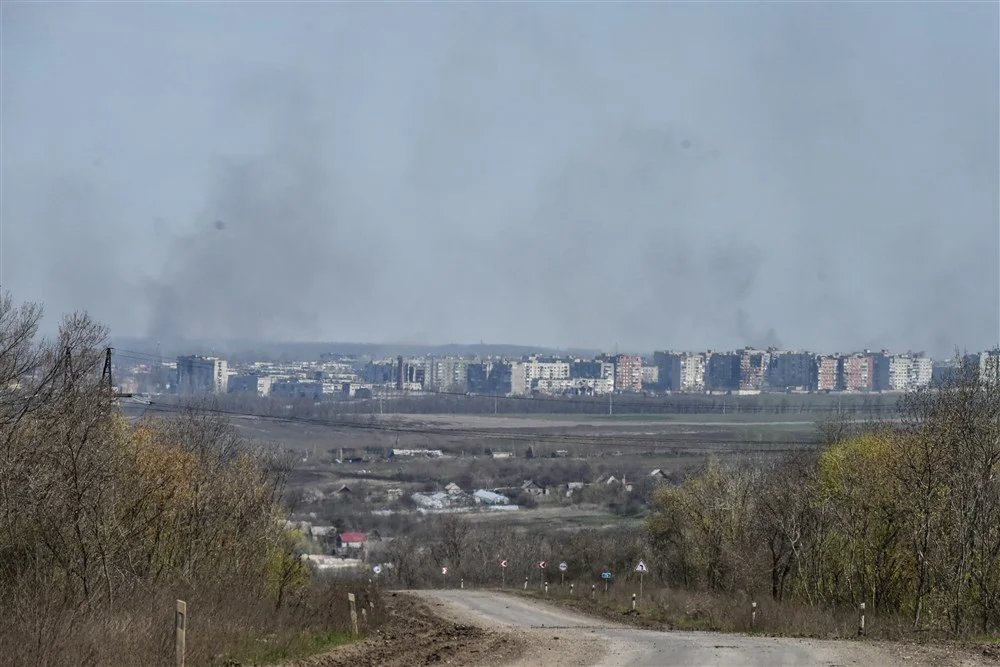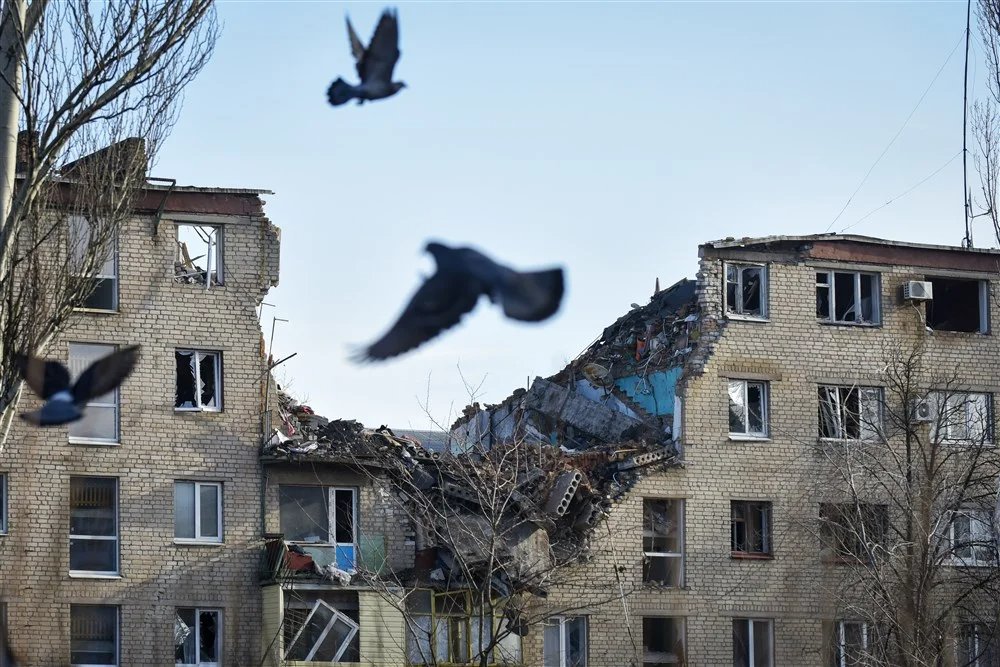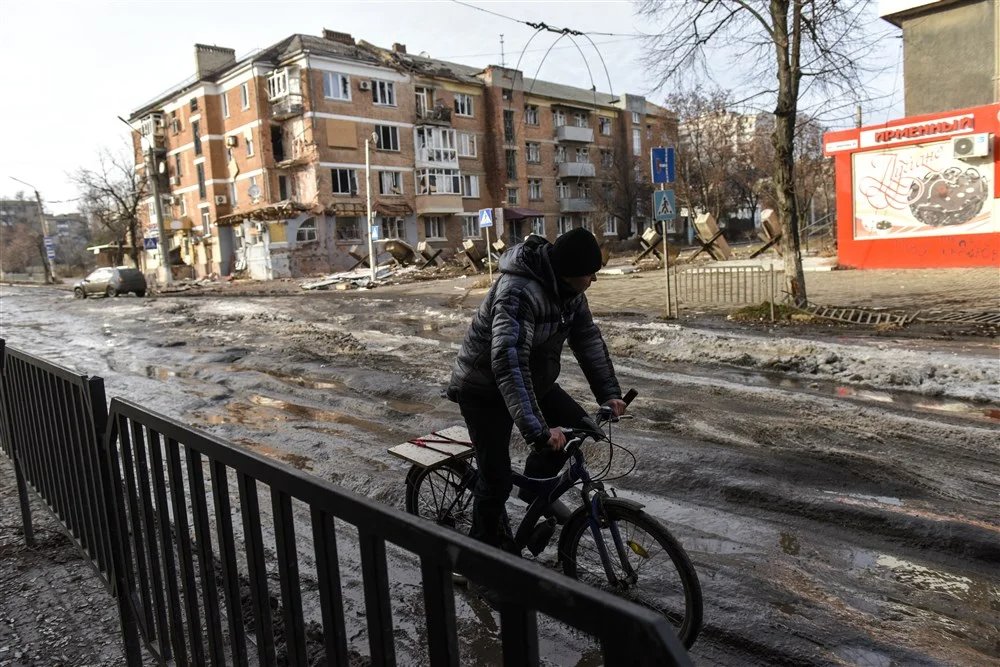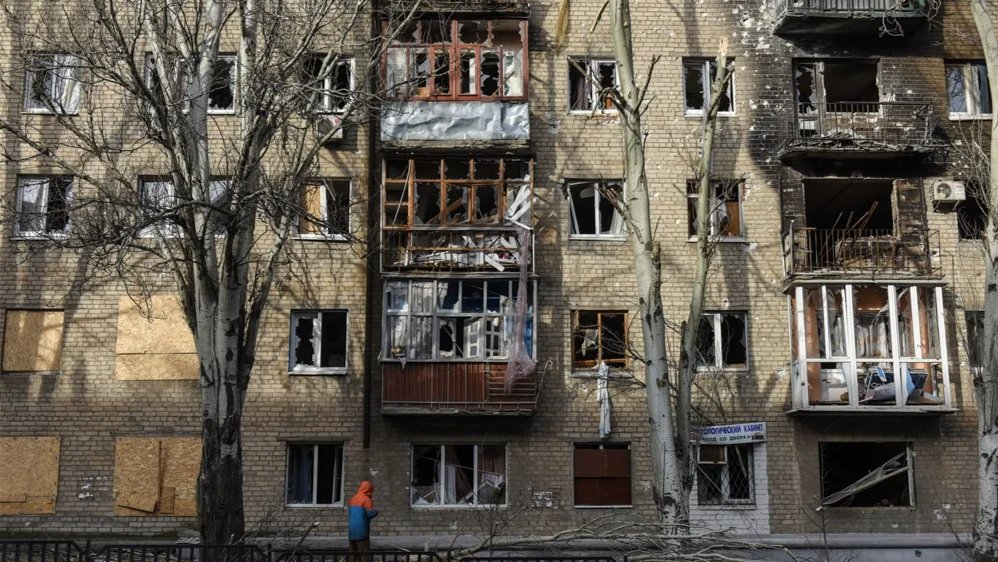According to US intelligence, Russia has suffered around 100,000 casualties (including killed and injured soldiers) in Ukraine over the last five months. The majority of these losses took place in the area surrounding the city of Bakhmut.
The offensive has petered out
Bakhmut is a city in the Donetsk region of Ukraine where around 70,000 people lived before the start of the full-scale invasion. Today, it’s almost entirely destroyed. Ukraine’s forces have been trapped there, half-encircled, for months. The majority of the city blocks are currently captured by the Russian army. The highway used for ammunition deliveries and troop rotations is constantly being shelled by Russian forces. However, Ukraine’s army continues its resistance from multi-storey buildings in the west of the city. Deadly street battles are ongoing.
White House National Security Spokesperson John Kirby thinks that Russia’s full-scale attacks in Donbas have petered out: “Last December, Russia initiated a broad offensive across multiple lines of advance, including toward Vuhledar, Avdiivka, Bakhmut, and Kreminna. Most of these efforts stalled and failed. Russia has been unable to seize any strategically significant territory.” The price of these attempts, especially in Bakhmut, according to Kirby’s data, was incredibly high. Russia exhausted its military reserves and forces.
Battle for Donbas
Israeli military observer David Sharp reminds readers of Novaya-Europe that active hostilities in the area of Bakhmut started back in May 2022. “In wars, a location, not even the most strategically important one, often becomes an arena for legendary battles, a place for both sides to use maximum force,” says David Sharp. “This happened with Verdun during WWI and Stalingrad during WWII. But if Germans had been able to pass the odd hundred of metres that separated them from the Volga River, nothing would have changed.”
In spring 2022, after Russian forces had withdrawn from the Kyiv, Chernihiv, Sumy, and parts of Kharkiv regions, their focus shifted to the so-called “battle for Donbas”. The Russian plan was, according to David Sharp, to encircle and destroy a huge Ukrainian grouping in the Sloviansk-Kramatorsk agglomeration by attacking from the “Izium ledge” and from another side via Bakhmut. That would have allowed Moscow to announce total control over the Donetsk region. By July, the cities of Severodonetsk and Lysychansk had been captured, and the forces moved towards Bakhmut. After the scattered Russian troops fled the Kharkiv region in September 2022,
the Bakhmut direction became basically the only one where the Russian army and various PMCs were waging active offensives.
Furthermore, the threat of the Armed Forces of Ukraine (AFU) being blocked near Sloviansk and Kramatorsk was entirely removed.
Ukrainian military expert and colonel in the AFU reserve Roman Svitan explains to Novaya-Europe the main reasons why the Russian army continues using more troops in attempts to capture the city. Svitan agrees that capturing Bakhmut would lead to the Russian troops having an operational space to then go on an offensive on the Sloviansk-Kramatorsk agglomeration. But he also named a different potential reason. The water pipeline from the Raihorodok village, which is used by Donetsk, Mariupol, and many other Donbas cities, goes through Bakhmut. From 2014 to 2022, Ukraine continued providing the self-proclaimed Donetsk and Luhansk “people’s republics” with water through this channel, but following the start of the full-scale invasion, substations were destroyed in shelling, and the water supply was halted. It is possible that the Russian authorities decided to turn the water back on by capturing the channel in its entirety.
Experts name other possible reasons for the Russian suicidal attack on Bakhmut. “After the de-occupation of Kherson, the Russian command tried to trap the maximum number of Ukrainian troops near Bakhmut,” head of the Military Legal Studies Centre Oleksandr Musiyenko tells Novaya-Europe. “Worried about AFU’s successes, the Russian troops increased the pressure in the eastern direction. They hoped that Ukraine would throw its reserves at the fight, which would make a counteroffensive impossible. However, Ukrainian servicemen are managing the difficult task of defending the city without using additional forces which are currently preparing to strike against the Russian army.”

Bakhmut. Photo: EPA
According to Musiyenko, Russians forces ended up falling into their own trap: having been unable to destroy Ukrainian forces, Moscow now has to constantly throw new reserves at capturing Bakhmut. Killed Wagner fighters are replaced with motorised infantry and paratroopers. Our interlocutor is certain that Ukraine’s actions in Bakhmut need to be viewed as preparation for a counteroffensive. Because the defence of the city has completed its task: by destroying a big number of combat-ready units, they disrupted the Russian assault on the city.
‘Cannon fodder assault’
When attacking the city, the command of the Russian army and PMCs uses a tactic known as “cannon fodder assault”. “Bakhmut is convenient in the sense that it’s easy to attack it using only infantry, there’s less need than usual to cover it with armoured vehicles,” says David Sharp. “The 50,000 criminals recruited in penal colonies were of use here: they were ready to fight in close combat in a dense city sprawl out of fear of being executed or because they were promised amnesty and rewards. One has to understand that detachments made up of convicts are not on par with the combined arms combat that servicemen are used to. Convicts don’t have enough training, coordination, and discipline for that. Although we are talking about units with minimal training, they were able to achieve a positive dynamic via suicidal bravery. Meanwhile, the group’s commanders demonstrated their preparedness not to count losses.” It turned out that PMC forces could continue the assault even in rainy or snowy conditions, when hostilities usually halt.
Fighting symbol
Capturing Bakhmut, it seems, turned out to be a matter of principle for the Russian government and for Yevgeny Prigozhin personally. But for Kyiv, too, the city became a symbol, so giving it up out of only military considerations would be a problematic endeavour. Even though many experts, including American ones, speculated that abandoning Bakhmut would be justified strategically, today the propaganda, media, and political angles play a part in the decision, too.
Kyiv is certain that if Russia comes out a winner of the “Bakhmut carnage”, Vladimir Putin will try to force Ukraine to make unacceptable decisions.
Ukraine’s President Volodymyr Zelensky explained his view on the subject, saying: “Putin will sell this victory to the West, the Russian public, China, Iran. If he smells blood, smells that we’re weak, he will start piling on pressure, pressure, pressure.” Furthermore, according to Zelensky, if Bakhmut falls, the Ukrainian public could start to experience fatigue and encourage the president to settle for a compromise.
‘Total mess’
However, the situation has started changing in Ukraine’s favour lately, according to headline-making reports from several sources. For example, Yevgeny Prigozhin, who’s considered the head of PMC Wagner, said in a recent interview with Russian “war correspondent” Semyon Pegov that his fighters are, indeed, suffering huge losses. “My boys are dying. Every day, in packs. Thousands, thousands of bodies, we get them out, put them in coffins, and send them home.”

Photo: ЕРА
The high number of casualties is explained by Prigozhin, not for the first time, by Wagner’s lack of ammunition. According to him, Russian military officials do not send the mercenaries enough ammo on purpose.
“I have a letter addressed to Defence Minister Sergey Shoigu,” Prigozhin said in the interview. “In short, I inform you that PMC Wagner is conducting the assault of Bakhmut and is facing serious issues with ammunition, the so-called ‘shell hunger’. The supplies of main types of artillery ammunition make up no more than 20-25% of what we need.”
When asking for immediate provision of ammunition, the head of Wagner is blackmailing the Defence Ministry’s leaderships and even Putin personally with the possibility of withdrawing his fighters from their positions:
“If the ammunition deficit is not fixed, then we will have to withdraw a part of detachments from this territory in an organised manner. And then, no matter what our bureaucrats claim, everything else will start collapsing, too…” Prigozhin said.
According to Roman Svitan, Prigozhin’s bold claims about withdrawing from Bakhmut could be due to the fact that Wagner units would need to withdraw from the areas they seized anyway, as they are now cornered by AFU from two sides and soon could be encircled.
David Sharp doesn’t rule out that Ukraine is planning to start advancing in this territory in the near future and throw out or encircle Wagner’s units. However, according to Sharp, as of now the Russian groups in Bakhmut are facing no threat. The Israeli military observer does not think the Bakhmut area is Ukraine’s priority for an attack.
He also calls Prigozhin’s public statements about a possible unauthorised withdrawal of his forces a clear overkill and stepping over all possible boundaries. “For a person like Prigozhin, this would be something he calls a ‘total mess’. The Russian command must be very surprised by these threats. I find it very hard to believe that one could withdraw troops and open a breach in a very difficult part of the front, all without an order from the command. This is a great demonstration of the general state that Russia’s Armed Forces find themselves in,” says David Sharp.
Sea of blood
John Kirby, citing declassified US intelligence documents, said that over 20,000 Russian servicemen had been killed in Ukraine since December 2022, and 80,000 more had been wounded. The official clarified that a significant part of these casualties occurred during the attacks on Bakhmut.
According to US intelligence, almost half of those killed were Wagner fighters, most of which were Russian convicts, thrown into the assault on Bakhmut without necessary combat experience, training, command, and without any resemblance of organised order in place.
“I suspect that over the span of the offensive in the Popasna — Soledar — Bakhmut direction that has been going on since last summer, the Russian army and PMCs have lost a total of 60,000 people, all of them killed,” Roman Svitan tells Novaya-Europe. “Since December, the Wagner Group has been able to advance 30 kilometres at most. I expect that the numbers announced by the Pentagon about the losses during the last five months are lower than the actual casualties, which could be up to 30,000 killed and up to 70,000 wounded, and these [wounded] will not be returning to the front.”

Photo: ЕРА
David Sharp thinks that the number of Russian losses announced by Kirby is the closest to the truth. According to him, US intelligence uses intel and data from satellites as well as intercepted correspondence and negotiations in their analysis.
However, our interlocutor brought up some reservations, too. “Very round numbers give me some doubt,” says David Sharp. “When they talk about 100,000 casualties of Russian servicemen, it almost looks as if they were using a generalisation. Usually, bulletins and reports feature minimal and maximum margins of error. Also, I think there are questions about the ratio of those killed to those injured. The US data says it’s 1:4. According to different estimates, there’s a maximum of 3.5 injured to 1 killed. And sometimes, due to Russia’s clear problems with tactical medicine and evacuation, and during attacks, this number can come down to 2.5. My guess is that in reality there are a bit more Russians that have been killed than the number the Americans are reporting.”
The total number of Russian casualties from 24 February 2022, according to Sharp’s information, has surpassed 250,000 and could very soon reach 300,000.
Ukrainians take care of their servicemen better. But they’re also suffering significant losses. John Kirby refused to comment on the estimates of Ukrainian losses, telling journalists that Washington will not make information that could complicate Ukraine’s position public.
A suitcase without a handle
“Today, it’s clear to everyone that Bakhmut is a suitcase without a handle for Russia,” says Roman Svitan. “Even if Ukraine were to withdraw its troops from the city, it wouldn’t change anything: several dozen kilometres further, there’s the fortified area of Sloviansk, Kramatorsk, Druzhkivka, and Kostyantynivka. They will definitely not be able to capture these cities. With the situation at hand, the Russian army’s command needs to withdraw from the captured territories and straighten out the front in Horlivka — Popasna — Lysychansk direction before the start of the Ukrainian counteroffensive. But Moscow is trapped by its own propaganda: people have been told about the importance of Bakhmut for months, so much blood has been spilled for its sake that a withdrawal will be hard to explain to citizens.”
Roman Svitan is certain that the detachments that are being prepared for Ukraine’s counteroffensive did not take part in the fighting for Bakhmut. All the forces that underwent training by allied countries and were equipped with lend-lease weapons are currently staying in reserve and are waiting for their moment. Today, it’s mostly Ukraine’s Special Operations Forces that are fighting in Bakhmut.
According to David Sharp, by the end of April, Ukraine had received basically all of the armoured vehicles and ammunition promised by the West. The training of crews for tanks, infantry fighting vehicles, armoured personnel carriers, and other machines has come to an end. The weather will soon be suitable for attacking. By all accounts, everything now depends on the Ukrainian military command making a decision to go on a counteroffensive.
However, the experts expect only tactical manoeuvres from Ukraine near Bakhmut. “AFU has no reason to start a full-scale offensive in Donbas, which is located on high ground,” says Roman Svitan. “This way, the entire army could perish. The attack will come from an unexpected place in the direction of the Azov Sea. The frontline in Kherson and Zaporizhzhia directions stretches out for hundreds of miles. The Ukrainian army is basically guaranteed to break through Russian positions and reach the coast, thus cutting off the land corridor into Crimea.” According to Svitan, the Ukrainian counteroffensive could begin after 6-7 May. The soil needs to dry up after the rains so that armoured vehicles don’t get stuck in the mud.
Join us in rebuilding Novaya Gazeta Europe
The Russian government has banned independent media. We were forced to leave our country in order to keep doing our job, telling our readers about what is going on Russia, Ukraine and Europe.
We will continue fighting against warfare and dictatorship. We believe that freedom of speech is the most efficient antidote against tyranny. Support us financially to help us fight for peace and freedom.
By clicking the Support button, you agree to the processing of your personal data.
To cancel a regular donation, please write to [email protected]

